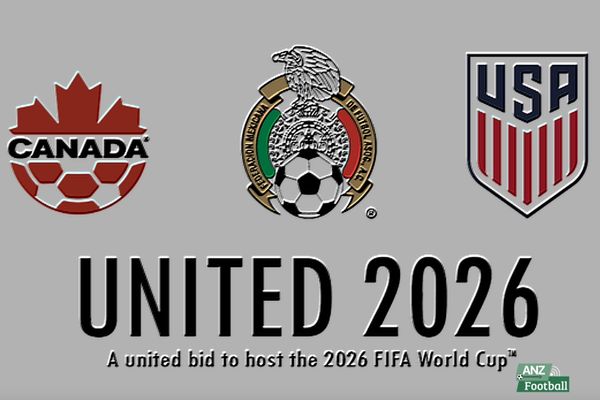Where is the 2026 World Cup? What is its format?
2 years agoFinally, after many days of waiting, the world football federation - FIFA has also made an official decision for the biggest football festival on the planet. The number of participating teams will increase from 36 to 48 teams in 2026. This is followed by a series of new announcements. So, what is the special thing waiting for world football fans at the World Cup that is about to take place in the next 3 years? Find out with ANZ Football!
Where is the 2026 World Cup hosted?
The 2026 World Cup will take place in North America for the first time in three years, co-hosted by the United States, Mexico and Canada. Mexico became the first country to host the World Cup three times after 1970 and 1986, while the United States hosted the World Cup twice after 1994. It is the first time for Canada to host the World Cup. Japan and South Korea were the first two-nation alliance to host this tournament.
New changes in the 2026 World Cup
The total number of teams increases to 48
Since the 2026 tournament in North America, FIFA will expand the World Cup into a playground of 48 teams. The work is both in line with the development trend of world football, and creates opportunities for many mid-range football teams to rise.
Many African and Asian countries are excited about this historic decision because they will also be the two regions that benefit the most from increasing the number of teams participating in the World Cup finals. Specifically, Europe still has the most capacity when increasing from 13 to 16 teams. Africa increased its capacity by four to nine. CONCACAF and South America both have six spots. Oceania will have an official slot instead of the current play off, while Asia will have 4 more slots to make up 8 official slots.
There will be a total of 46 official tickets to the 2026 World Cup and the remaining two will be determined through the intercontinental round. Two teams representing CONCACAF and South America, Asia, Oceania and Africa - one representative each - will enter the playoffs to determine the final two tickets to the 2026 World Cup.
According to FIFA's latest announcement, all three teams including US, Canada and Mexico are automatically qualified for the 2026 World Cup finals as hosts. These three slots will be included in the CONCACAF region, so only three teams from North, Central America and the Caribbean will qualify. In addition, the three countries will nominally co-host but the United States will largely avoid hosting matches from the quarter-finals.
New format: 12 groups and 4 teams
Next is a change in the format of the group stage. FIFA had planned to split the 48 into 16 groups of three teams. This method aims to minimize innocuous matches at the end of each group because there will be teams who win tickets after only the first 2 matches, thereby improving the quality of the match. In case one team has 1 win and 1 loss, that team still has a chance to continue.
With this format, the 2026 World Cup will have 80 matches, an increase of 16 matches compared to the 64 matches that FIFA has applied since 1998. However, the downside is the loss of the attraction of the last leg taking place at the same time when the groups only have 3/4 teams as in previous World Cups. In addition, the fact that the group has three teams increases the possibility that the two teams directly confronting in the last round may collude to produce a result in their favor. This happened at the 1982 World Cup in Spain when West Germany beat Austria 1-0 to advance together and cause Algeria to be eliminated.
So on 15 March, FIFA officially announced the abandonment of this option at the 2026 World Cup and kept the option of 4 teams 1 group, a total of 12 groups instead of 16 groups. This also ensures balance and rest, recovery for each team after each game. FIFA President Gianni Infantino said:
FIFA counts many options and changes just to find the best way to bring more quality matches, high dedication. Now, professional and technical departments have chosen this format. It is the optimal plan to minimize the meaningless matches, ensure the balance and recovery time of the teams.
So with this new format, in addition to having the first and second teams of each group enter the round, 8 more teams will be picked up. The 3rd place team in each group with the best record will be entered into the round of 32 teams. From the round of 32 teams will proceed to knock-out matches.
Increase the total number of matches and the duration of the tournament
With a 48-team format, the 2026 World Cup will feature all 104 matches, including 72 group stage matches, 32 matches in the 16 round, 16 matches in the 8 round, 4 quarter-finals, 2 semi-finals, third place matches and finals. The winning team also had to play 8 matches instead of 7 matches as before.
The award will be extended for at least one week, for a total of 39 days. And the 2026 tournament co-hosted by the US, Canada and Mexico will become the longest World Cup ever.
The meaning of the 48-team format at the 2026 World Cup
For world football
According to FIFA, participating in the World Cup will be the motivation for weaker football teams to develop. With this change, the World Cup is probably no longer something far-fetched for many mid-range teams, but it will turn into a real festival of all countries in the world.
However, besides this beautiful gesture, many people also think that the day of the biggest football on the planet will lose its inherent quality, many people are concerned that increasing the number of participants to 48 teams can make the World Cup lose its appeal. The participation of many teams who are much weaker in terms of level can cause the tournament to be diluted.
In addition, the prolonged schedule accompanied by the number of matches increased, making the quality of the world's most prestigious tournament facing the risk of serious decline. When the player has reached the physical and mental limits, the performance on the pitch will certainly not be able to meet the professional requirements.
For football clubs
While many countries have welcomed the change that FIFA is about to make, many people believe that having to extend the playing time as well as increasing the number of teams will reduce the appeal of the biggest football festival on the planet. These changes could make it difficult for clubs to have players in the World Cup, although FIFA will shorten the preparation period for the tournament to 17 days instead of 24 days like before.
Victor Montagliani, the president of the North American football federation, has concerns about an already tight schedule: We are responsible for the duration of the World Cup and there have been complaints about the dates of the 2014 and 2018 World Cups. We can't get over that. We can't hold the World Cup for three months.
The change in format may lead to some scheduling issues arising for host countries as well as the addition of new venues. The plan was initially drafted on the assumption that there would be 80 matches. The organizers then allocated 60 matches to be held in the United States, 10 matches in Canada and the remaining 10 matches in Mexico. There are now 24 more games that need to be taken into account.
For FIFA
FIFA may not be too concerned about the impact. Many analysts believe that the increase in the number of teams participating in the World Cup to have more matches means FIFA will have more television rights. This amount accounts for 90% of the revenue the World Cup brings to FIFA. Last month, FIFA said the World Cup in Qatar earned $7.5 billion from royalties and sponsorship revenue, $1 billion more than the 2018 World Cup finals in Russia. And this new format will be an opportunity to make money they cannot ignore.
Of course, nominally, FIFA never mentioned that huge source of profit. Speaking to the press, chairman Gianni Infantino explained that he wants to move towards a more comprehensive tournament.
Conclusion
The story of the World Cup will probably continue to be hot in the coming days. FIFA regulations have had supportive opinions, but there are also many conflicting opinions. For the big teams and countries, they can confirm their strength in this sport. For small countries which do not have many opportunities to swim to the big sea, this is like a decision to help them nurture their hopes and wishes to participate in a tournament that they never thought they would touch.
Other news

Champions League vs. Europa League: Which One is Better?
2 years ago
Champions League vs Premier League: What Is The Key Difference?
2 years ago
Where to watch the Champions League final? Ultimate Guideline 2023
2 years ago
Top 5 Best Strikers In Europe 2023
2 years ago
Eden Hazard Biography and His Up and Down Football Career
2 years ago